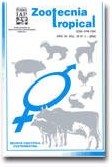
|
Zootecnia Tropical
Instituto Nacional de Investigaciones Agrícolas Venezuela
ISSN: 0798-7269
Vol. 26, No. 2, 2008, pp. 125-131
|
 Bioline Code: zt08016
Bioline Code: zt08016
Full paper language: Spanish
Document type: Research Article
Document available free of charge
|
|
|
Zootecnia Tropical, Vol. 26, No. 2, 2008, pp. 125-131
| en |
Residual Effect of Lime, Nitrogen and Zinc on Dry Matter Production of Brachiaria Decumbens  in Field Conditions in Field Conditions
Fernandes, Francisco Maximino; de Mello Prado, Renato; Kawatoko, Massaru & Isepon, Olair J.
Abstract
The balance of liming and fertilization practice with nitrogen and zinc could affect the production of the pasture. Thus, the present work has as objective to evaluate the residual effect of the application of calcareous rock, nitrogen, and zinc on the dry matter production of Brachiaria decumbens

, during three cuts. For this, an experiment was installed in Selvíria, Brazil, on a distrofic red Latosol, from october 1997 to may 1998. The experimental design was randomized blocks, in a factorial project 3x3x2, with four repetitions. The treatments were three doses of nitrogen: 0, 50, and 100 kg/ha, three doses of lime: 0, 267, and 556 kg/ha, corresponding to 41, 50, and 60% of the levels of base saturation, respectively, and two doses of zinc 0 and 5 kg/ha, applied in the first year and reapplied in the second year, except for the limestone. Four cuts were done in the grass at 10 cm of height, with intervals of 49 days, to obtain the dry matter production. The limestone application in the first year did not provide to residual effect on the production of Brachiaria decumbens,. However, the nitrogen fertilization increased the dry matter production of the grass. The application of zinc in the first year and the reapplication in the second year did not result in a productive response of B. decumbens.
grass, fertilizantion nitrogen, limestone, micronutrient, restauration.
|
| |
| es |
Efeito Residual de Calcário, Nitrogênio e Zinco na Produção de Matéria Seca de Brachiaria Decumbens  em Condições de Campo em Condições de Campo
Fernandes, Francisco Maximino; de Mello Prado, Renato; Kawatoko, Massaru & Isepon, Olair J.
Resumen
O equilíbrio da prática da calagem e da adubação com nitrogênio e zinco poderá afetar a produção do pastura. Assim, o presente trabalho tem como objetivo avaliar o efeito residual da aplicação de calcário, nitrogênio e zinco na produção de matéria seca da Brachiaria decumbens

, durante três cortes. Para isto, instalou-se um experimento em Selvíria, Brasil, em um Latossolo Vermelho distrófico, no período de outubro 1997 a maio 1998. O delineamento experimental adotado foi em blocos casualizados, em esquema fatorial 3x3x2, com quatro repetições. Os tratamentos foram compostos por três doses de nitrogênio: 0, 50 e 100 kg/ha, três doses de calcário: 0, 267 e 556 kg/ha, correspondendo aos níveis de saturação por bases 41, 50 e 60%, respectivamente e duas doses de zinco 0 e 5 kg/ha, aplicados no primeiro ano e reaplicados no segundo ano, exceto o calcário. No segundo de experimentação, realizou-se três cortes na forrageira à 10 cm do solo, com intervalos de 49 dias, para obtenção da matéria seca. A aplicação de calcário no primeiro ano, não proporcionou efeito residual no segundo ano sobre a produção da Brachiaria decumbens,. Enquanto, que a adubação nitrogenada, proporcionou incrementando a produção de matéria seca da forrageira. A aplicação de zinco no primeiro ano e reaplicação no segundo ano, não resultou em resposta da B. decumbens na produção de matéria seca.
pastagem, nitrogênio, calagem, micronutriente, restauração.
|
| |
© Copyright 2005 - Zootecnia Tropical
Alternative site location: http://www.sian.inia.gob.ve/repositorio/revistas_ci/ZootecniaTropical/ztindice.htm
|
|
